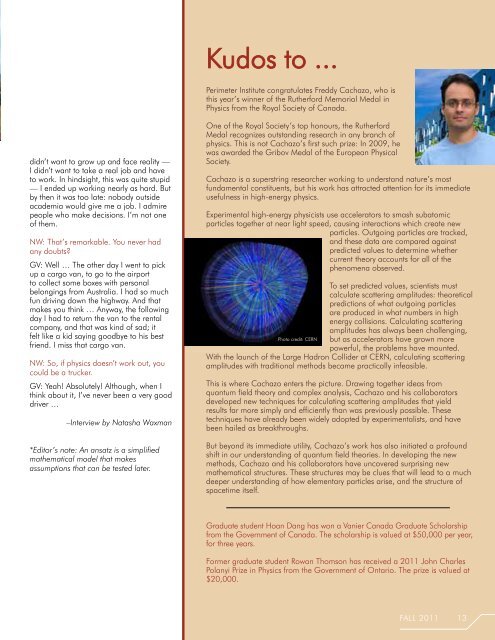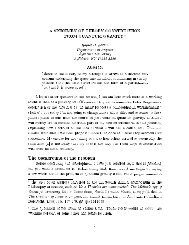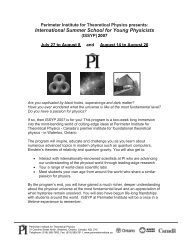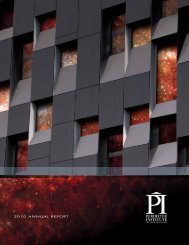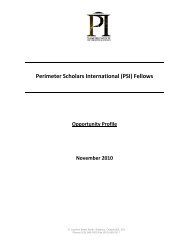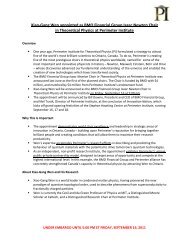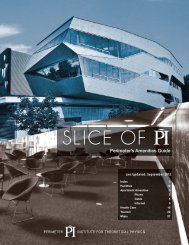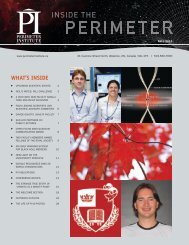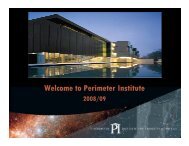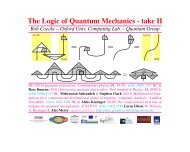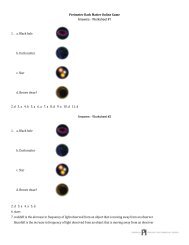i n s i d e t h e p e r i m e t e rp i n e w sA Chat withGuifre VidalGuifre Vidal recently arrived at PI as asenior Faculty member in condensedmatter. His past honours include anAustralian Research Council FederationFellowship, a European Union MarieCurie Fellowship, a Sherman FairchildFellowship, and a Distinguished ResearchChair at <strong>Perimeter</strong> <strong>Institute</strong>. Here he tellsus a little bit more about himself.NW: Welcome! Please tell me a bit aboutyour background, and where you’recoming from.GV: I grew up in Barcelona, wherein 1999 I obtained a PhD in Physicsfrom the University of Barcelona. I didtwo postdocs, one at the University ofInnsbruck, Austria, and one at the <strong>Institute</strong>for Quantum Information at the California<strong>Institute</strong> of Technology. From 2005 anduntil recently, I was a Professor in theSchool of Mathematics and Physics at theUniversity of Queensland, in Brisbane,Australia, where I built a research groupin quantum information, computationalphysics, and condensed matter.NW: Well, we’re glad to have you here at<strong>Perimeter</strong>! How are you settling in?GV: <strong>Perimeter</strong> has been very welcoming.And I like Canada. One thing I like is thatit’s a really multicultural country and that’sperfect for my family. I have a Europeanand now Australian background and mywife, Dora, is originally from Hong Kongand then Australia. We sense that we willfit naturally here. Our son Marc is justseven months old, and growing fast. He’sbusy learning Cantonese and Catalan —well, that’s what we think he’s doing. It’sall good, except that he’s going to have aCanadian accent instead of an Australianone. Yeah, I’m very excited to be here. I’llprobably stay excited until the first snowfalls.NW: Er … Have you ever lived in a snowyclimate?GV: My first postdoc was at Innsbruck— it’s in the Alps. It’s like here, but withmountains. I don’t seeany mountains here.Actually, I’ve been toPI several times before.Last May was the first time when therewasn’t any snow. It was the first time I sawpavement here and thought, “Oh, there ispavement on the roads.” Until then, I wasunder the impression that the roads inWaterloo were made of snow.NW: Buy a good shovel — you’re goingto need it. Snow aside, what attracted youto <strong>Perimeter</strong>?GV: <strong>Perimeter</strong> lets me concentrate onresearch. That’s what I prefer to do. Iprefer to stay simple so that I can spendmy time thinking about physics, asopposed to having to manage a largeresearch group.NW: Can you give us the broad strokesof your research? What are you interestedin?GV: The long-term goal of my researchis to better understand quantum manybodyphysics and quantum entanglement.I’m very interested in understanding whathappens when you put lots of microscopicdegrees of freedom together with simpleinteractions. We get collective behaviors,emergent behaviors — but exactly whatemerges, and how? That’s often still kindof a mystery. I’d like to develop bettertheoretical tools to derive or predict theseemergent behaviors starting from themicroscopic descriptions.NW: A mystery that crops up in a numberof different fields ...GV: That’s right. I started studyingentanglement in the context of quantumcomputing, where it’s used as a resourcefor quantum information processing.Nowadays, entanglement is alsointensively studied in the broader contextof quantum many-body physics. Forinstance, entanglement offers a naturaltheoretical framework to study quantumphases of matter, which would usuallybe considered part of condensed matterphysics. The quantum many-body problemalso has implications for quantum fieldtheory, string theory, quantum gravity, etc.It’s exciting to do work that could havesuch broad implications.NW: What are you working on right now?What’s got you excited?GV: What I’ve been doing lately is workon tensor networks. A tensor network is anansatz* for the many-body ground stateon a lattice system. One particular type oftensor network, based on renormalizationgroup ideas, is a promising step towardsanswering the question I asked beforeabout deriving emergent collectivephenomena starting from a microscopicdescription. In addition, some colleagueshave recently shown how to generalizetensor networks from the lattice (spinsystems) to the continuum (field theories),which is leading us towards new nonperturbativeapproaches to quantum fieldtheories.NW: So how did you become interested inphysics in the first place?GV: I have no idea. It just seems I’vealways been interested in it. I do knowthat, as a boy, I was very happy the dayI learned that my father had studiedphysics. I had been very interested in thesebooks that talked about physics stuff buthad not realized that it might have beenan inherited passion. I never consideredanything else. That doesn’t mean thatI was completely focused on physics,just that pursuing an academic careerin physics appeared as a natural path.Actually, laziness has probably been thesingle most influential factor shaping thispath. For instance, I did not decide that Iwanted to go to university, or do a PhD, oreven start a first postdoc. In each of theseoccasions, what I really decided was that I12 Fall 2011
Kudos to ...<strong>Perimeter</strong> <strong>Institute</strong> congratulates Freddy Cachazo, who isthis year’s winner of the Rutherford Memorial Medal inPhysics from the Royal Society of Canada.didn’t want to grow up and face reality —I didn’t want to take a real job and haveto work. In hindsight, this was quite stupid— I ended up working nearly as hard. Butby then it was too late: nobody outsideacademia would give me a job. I admirepeople who make decisions. I’m not oneof them.NW: That’s remarkable. You never hadany doubts?GV: Well … The other day I went to pickup a cargo van, to go to the airportto collect some boxes with personalbelongings from Australia. I had so muchfun driving down the highway. And thatmakes you think … Anyway, the followingday I had to return the van to the rentalcompany, and that was kind of sad; itfelt like a kid saying goodbye to his bestfriend. I miss that cargo van.NW: So, if physics doesn’t work out, youcould be a trucker.GV: Yeah! Absolutely! Although, when Ithink about it, I’ve never been a very gooddriver …–Interview by Natasha Waxman*Editor’s note: An ansatz is a simplifiedmathematical model that makesassumptions that can be tested later.One of the Royal Society’s top honours, the RutherfordMedal recognizes outstanding research in any branch ofphysics. This is not Cachazo’s first such prize: In 2009, hewas awarded the Gribov Medal of the European PhysicalSociety.Cachazo is a superstring researcher working to understand nature’s mostfundamental constituents, but his work has attracted attention for its immediateusefulness in high-energy physics.Experimental high-energy physicists use accelerators to smash subatomicparticles together at near light speed, causing interactions which create newparticles. Outgoing particles are tracked,and these data are compared againstpredicted values to determine whethercurrent theory accounts for all of thephenomena observed.To set predicted values, scientists mustcalculate scattering amplitudes: theoreticalpredictions of what outgoing particlesare produced in what numbers in highenergy collisions. Calculating scatteringamplitudes has always been challenging,Photo credit: CERN but as accelerators have grown morepowerful, the problems have mounted.With the launch of the Large Hadron Collider at CERN, calculating scatteringamplitudes with traditional methods became practically infeasible.This is where Cachazo enters the picture. Drawing together ideas fromquantum field theory and complex analysis, Cachazo and his collaboratorsdeveloped new techniques for calculating scattering amplitudes that yieldresults far more simply and efficiently than was previously possible. Thesetechniques have already been widely adopted by experimentalists, and havebeen hailed as breakthroughs.But beyond its immediate utility, Cachazo’s work has also initiated a profoundshift in our understanding of quantum field theories. In developing the newmethods, Cachazo and his collaborators have uncovered surprising newmathematical structures. These structures may be clues that will lead to a muchdeeper understanding of how elementary particles arise, and the structure ofspacetime itself.Graduate student Hoan Dang has won a Vanier Canada Graduate Scholarshipfrom the Government of Canada. The scholarship is valued at $50,000 per year,for three years.Former graduate student Rowan Thomson has received a 2011 John CharlesPolanyi Prize in Physics from the Government of Ontario. The prize is valued at$20,000.fall FALL 2011 13


